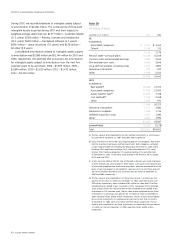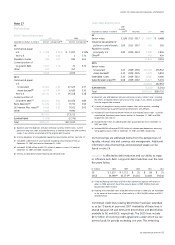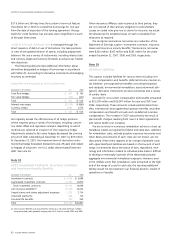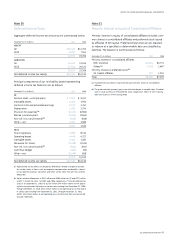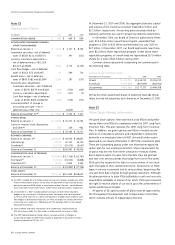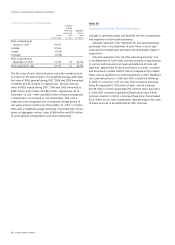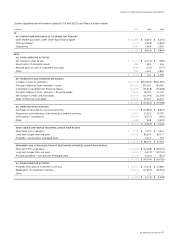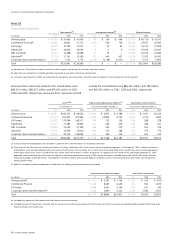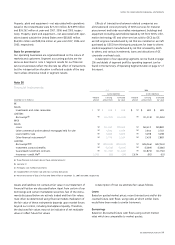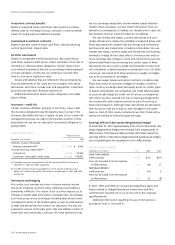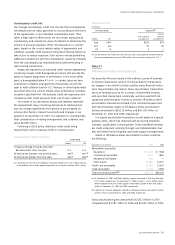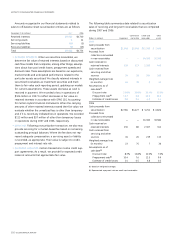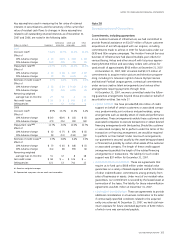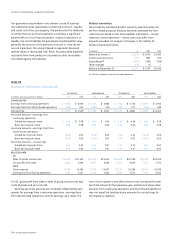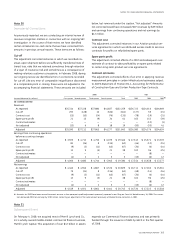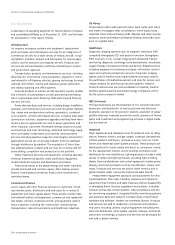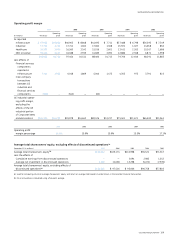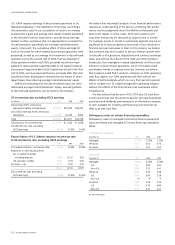GE 2007 Annual Report Download - page 102
Download and view the complete annual report
Please find page 102 of the 2007 GE annual report below. You can navigate through the pages in the report by either clicking on the pages listed below, or by using the keyword search tool below to find specific information within the annual report.
100 ge 2007 annual report
are not exchange-traded with internal market-based valuation
models. When necessary, we also obtain information from our
derivative counterparties to validate our models and to value the
few products that our internal models do not address.
We use interest rate swaps, currency derivatives and com-
modity derivatives to reduce the variability of expected future cash
fl ows associated with variable rate borrowings and commercial
purchase and sale transactions, including commodities. We use
interest rate swaps, currency swaps and interest rate and currency
forwards to hedge the fair value effects of interest rate and cur-
rency exchange rate changes on local and non functional currency
denominated fi xed-rate borrowings and certain types of fi xed-
rate assets. We use currency swaps and forwards to protect our
net investments in global operations conducted in non-U.S. dollar
currencies. We intend all of these positions to qualify as hedges
and to be accounted for as hedges.
We use swaps, futures and option contracts, including caps,
fl oors and collars, as economic hedges of changes in interest
rates, currency exchange rates and equity prices on certain types
of assets and liabilities. We sometimes use credit default swaps
to economically hedge the credit risk of various counterparties
with which we have entered into loan or leasing arrangements.
We occasionally obtain equity warrants as part of sourcing or
fi nancing transactions. Although these instruments are derivatives,
their economic risks are similar to, and managed on the same
basis as, risks of other equity instruments we hold. These instru-
ments are marked to market through earnings.
Earnings effects of derivatives designated as hedges
At December 31, 2007, approximately 53% of our total interest rate
swaps designated as hedges were exempt from ongoing tests of
effectiveness. The following table provides information about the
earnings effects of derivatives designated and qualifying as hedges,
but not qualifying for the assumption of no ineffectiveness.
PRE-TAX GAINS (LOSSES)
December 31 (In millions) 2007 2006 2005
CASH FLOW HEDGES
Ineffectiveness $ (3) $ 10 $(27)
Amounts excluded from the measure
of effectiveness (17) (16) 17
FAIR VALUE HEDGES
Ineffectiveness 7 (47) 4
Amounts excluded from the measure
of effectiveness (13) 33 (8)
In 2007, 2006 and 2005, we recognized insignifi cant gains and
losses related to hedged forecasted transactions and fi rm
commitments that did not occur by the end of the originally
specifi ed period.
Additional information regarding the use of derivatives is
provided in note 17 and note 22.
Investment contract benefits
Based on expected future cash fl ows, discounted at currently
offered rates for immediate annuity contracts or cash surrender
values for single premium deferred annuities.
Guaranteed investment contracts
Based on present value of future cash fl ows, discounted using
current benchmark interest rates.
All other instruments
Based on comparable market transactions, discounted future
cash fl ows, quoted market prices, and/or estimates of the cost to
terminate or otherwise settle obligations. The fair values of our
cost method investments that are not exchange traded represent
our best estimates of amounts we could have received other
than on a forced or liquidation basis.
Assets and liabilities that are refl ected in the accompanying
fi nancial statements at fair value are not included in the above
disclosures; such items include cash and equivalents, investment
securities and derivative fi nancial instruments.
Additional information about certain categories in the table
above follows.
Insurance — credit life
Certain insurance affi liates, primarily in GE Money, issue credit
life insurance designed to pay the balance due on a loan if the
borrower dies before the loan is repaid. As part of our overall risk
management process, we cede to third parties a portion of this
associated risk, but are not relieved of our primary obligation to
policyholders.
LOAN COMMITMENTS
Notional amount
December 31 (In millions) 2007 2006
Ordinary course of business
lending commitments (a) $ 12,854 $ 9,945
Unused revolving credit lines (b)
Commercial 26,305 24,963
Consumer — principally credit cards 454,089 476,831
(a) Excluded investment commitments of $4,393 million and $2,881 million as of
December 31, 2007 and 2006, respectively.
(b) Excluded inventory fi nancing arrangements, which may be withdrawn at our
option, of $12,848 million and $11,044 million as of December 31, 2007 and 2006,
respectively.
Derivatives and hedging
We conduct our business activities in diverse markets around
the world, including countries where obtaining local funding is
sometimes ineffi cient. The nature of our activities exposes us to
changes in interest rates and currency exchange rates. We manage
such risks using various techniques including debt whose terms
correspond to terms of the funded assets, as well as combinations
of debt and derivatives that achieve our objectives. We also are
exposed to various commodity price risks and address certain of
these risks with commodity contracts. We value derivatives that


